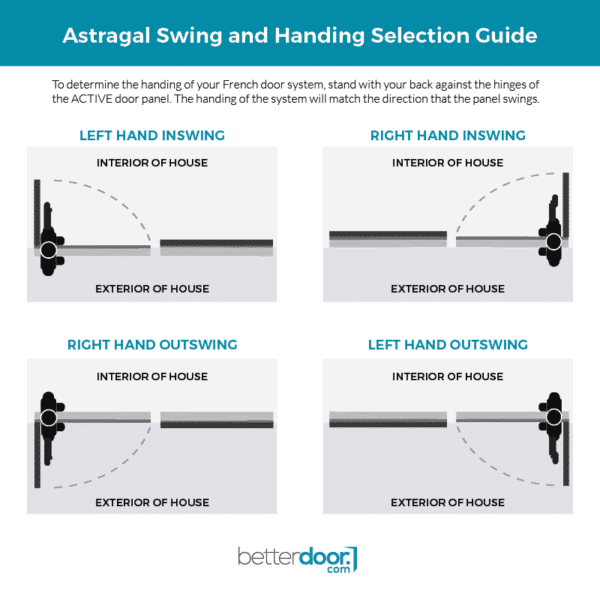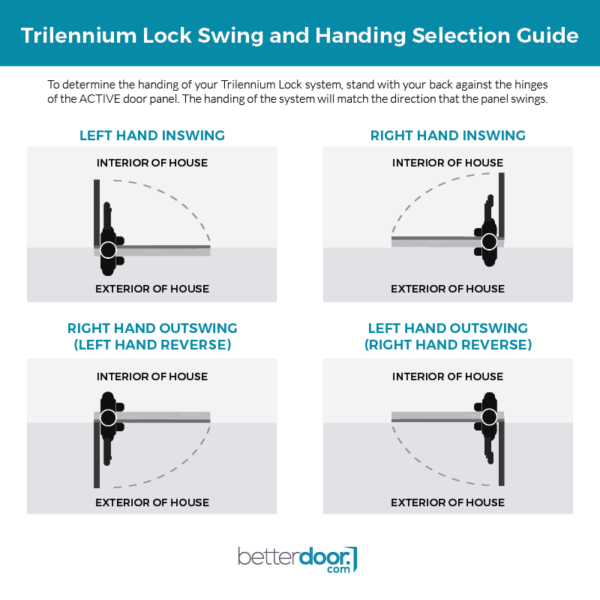When ordering new door or replacement parts for a door, it’s crucial to understand the terminology that identifies the type of door you have. The swing of a door, which is essentially how the door opens, affects the style, fit, and its functionality. In this post, we’ll cover how to tell if your door is inswing or outswing, as well as its handing and how these factors apply to some of the door components we sell.
How do I tell if a door is an inswing door or an outswing door?
For Exterior Doors
If you’re dealing with an exterior door, make sure you’re standing outside of the building facing the door as if you’re about to walk inside.
If you push the door to enter, it is an inswing door. If you pull the door to enter, it is an outswing door.
For Interior Doors
For interior doors, the logic is similar. Start by standing in front of the door. The room you’re about to enter is considered the interior, while the space you’re currently standing in would be the exterior. For example, if you’re in a hallway facing a bedroom door, you’re outside of the bedroom.
Again, push = inswing and pull = outswing. If the door swings forward and away from you towards the interior of the room you’re facing, it is an inswing door. If you pull the door toward you and away from the interior of the room you’re facing, it is an outswing door.
How we determine if the door is Left-Handed or Right-Handed
It’s important to keep in mind that door swing and handing are related but different. Door handing refers to whether the door is right-handed or left-handed. While handing can depend according to manufacturer, this is how we determine handing here at BetterDoor. (Always double check before buying elsewhere!)
If you want to double check the handedness of a door, stand with your back against the hinge jamb with the door open. If your back is to the hinges, and the door swings to your left, it is a left-hand door. If your back is to the hinges and the panel swings to your right, it is a right-hand door.
How Does This Affect Door Components?
Again, these factors will affect your door depending on your manufacturer. But when it comes to our BetterDoor components, here are a few helpful tips to keep in mind when shopping!
For Astragals
When replacing parts like door sills and astragals, it’s crucial that you know whether a door is a right-handed or left-handed door, along with whether it’s an inswing or outswing door.
For our astragal systems, handing is done by putting your back to the hinges of the active (primary) door panel. With your back to the hinges, is the door panel swinging to the left side of your body or the right side? If it is swinging to the left, it is a left handed door. If it swinging to the right, it is a right handed door.

For Trilennium®
For our Trilennium® locking systems and handsets, it’s even easier to check the handing. When standing outside the door, look at the active panel. Which side are the hinges located—left or right? If they’re on the left side, it is a left-handed door. If they’re on the right, it’s a right-handed door.
As seen in the graphic below, if it’s an outswing door with the hinges on the left-hand side, your door is left-hand reverse. If the hinges are on the right-hand side on an inswing door, the door is right-handed, The door is a right-hand reverse if it’s an outswing.
Please note: a Left Hand Reverse System is the equivalent to a Right Hand Outswing. Alternatively, a Right Hand Reverse System is the equivalent to a Left Hand Outswing.

